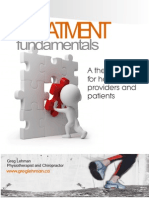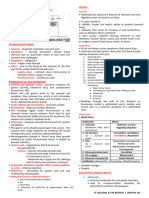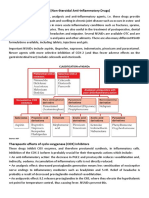Acut Nyaki Fájdalom
Acut Nyaki Fájdalom
Uploaded by
reka68Copyright:
Available Formats
Acut Nyaki Fájdalom
Acut Nyaki Fájdalom
Uploaded by
reka68Original Title
Copyright
Available Formats
Share this document
Did you find this document useful?
Is this content inappropriate?
Copyright:
Available Formats
Acut Nyaki Fájdalom
Acut Nyaki Fájdalom
Uploaded by
reka68Copyright:
Available Formats
Information Sheet | February 2004
Number
Acute Neck Pain
A partnership approach to pain management
>What Is Acute Neck Pain?
Acute neck pain is pain felt in the region of the neck that lasts for a short time (i.e. less than three months). Statistics show that around 1015% of the population has neck pain at any given time. While the duration of symptoms varies from person to person, it is not uncommon for neck pain to be persistent. The pain intensity can range from mild to severe.
Should >WhatWhen I Do I Have Acute Neck Pain?
MAIN MESSAGES
Work with your health practitioner to manage your pain and address your concerns
If your pain bothers Stay active you, it is important to see your health practitioner, to work with them to manage your pain, and to stay active.
>What Causes Acute Neck Pain?
In most cases it is not possible to pinpoint the cause of the neck pain, or it may be the result of an injury. In either case, it is not necessary to have a specific diagnosis of the cause in order to manage the pain effectively. There is a less than 1% chance that the pain is due to a serious medical condition.
1See your health practitioner
A history and a physical examination are needed to assess for any serious medical conditions that may be associated with your pain, although these are rare. Your practitioner can provide you with information about your pain after you have been assessed. Ask for an explanation if unfamiliar
WHAT THE RESEARCH SAYS
panel of experts Athe effectiveness ofrecently reviewed the scientific studies on treatments for acute neck pain. They found that there is both a lack of evidence (i.e. few or no scientific studies conducted) and a lack of high quality studies on pain-relieving treatments in this area. The findings of this review are published in the report Evidence-Based Management of Acute Musculoskeletal Pain available at www.nhmrc.gov.au. The results of this review are summarised below.
Effective
gentle neck exercises (these can be started soon after the pain starts); combined (or multi-modal) treatments involving cervical passive mobilisation with exercises, or exercises with other types of treatments; and pulsed electromagnetic therapy (reduces pain in the short term).
Inconclusive*
manipulation, cervical passive mobilisation, gymnastics, multi-disciplinary treatment in the workplace, muscle relaxants, neck school, patient education, spray and stretch therapy and traction for the treatment of acute neck pain.
Not effective
Studies on TENS, electrotherapy and micro-breaks (small breaks from computer work) for acute neck pain have not tested these treatments against placebo.
No studies done*
There is scientific evidence that neck collars are not effective for acute neck pain.
Measures that are effective for relieving acute neck pain are: staying active and keeping the neck moving;
There are no studies that have looked at: acupuncture, pain-relieving medication (analgesics), anti-inflammatory drugs (NSAIDs), cervical
note that these * It is important to that these measfindings do not mean ures will not help you; they indicate that more research is needed.
Acute Neck Pain
terms are used. Sometimes a diagram can be useful. Additional investigations, such as xrays and blood tests, are not needed in the majority of cases of acute neck pain. They do not help with your pain or your ability to move your neck. It is normal to worry about the cause of your pain and the impact it may have on you. Talking to your health practitioner about your concerns can be helpful. You will usually find there is no serious cause and that there are ways to relieve neck pain.
What measures are available to relieve acute neck pain (what they involve, how they work, their benefits and risks, their effectiveness) Your need for additional information
3 Stay Active
Your pain may make it difficult for you to carry out your usual activities, and you might want to avoid moving your neck. However, it is important to resume normal activities as soon as possible. Maintaining the use of your neck helps to prevent long-term problems. You may need to use pain-relieving measures to help you return to your usual activity level. If you are working, the plan could include a program of selected duties or reduced hours of work. This applies to work at home as well.
2 Work with your health practitioner to manage your pain
The goal is to help you find ways to manage your pain and return to your usual activities. Most people find that their neck pain settles down over time as healing occurs. Pain-relieving measures may help you cope with your symptoms while nature takes its course. There is a range of pain-relieving measures available. While there are few scientific studies proving their effectiveness, this does not mean that a particular measure will not help you (see What the Research Says). When considering what measures to use for your pain, it is helpful to discuss the following with your health practitioner:
Follow-up visits It is important to maintain contact with your health practitioner. If the pain is not settling down or is getting worse, you may need further assessment. Follow-up visits provide you with an opportunity to obtain more information. If you have any questions to ask your health practitioner, write them down and discuss them at your next visit.
Your pain level and your concerns
The content of this information sheet is based on: Australian Acute Musculoskeletal Pain Guidelines Group (2003). Evidence-Based Management of Acute Musculoskeletal Pain, available at www.nhmrc.gov.au The project was funded by the Department of Health and Ageing, Canberra.
Copyright 2003 Australian Acute Musculoskeletal Pain Guidelines Group ISBN 1864962402
Further copies of this information sheet are available from: www.nhmrc.gov.au/
You might also like
- Script Forum (Moderator)Document3 pagesScript Forum (Moderator)aisyah83% (36)
- Cabo H. Color Atlas of Dermoscopy 2018Document354 pagesCabo H. Color Atlas of Dermoscopy 2018Esther Parvu100% (1)
- Pain Relief Without Drugs or SurgeryDocument50 pagesPain Relief Without Drugs or SurgeryNora100% (3)
- 5 Ways To Treat Chronic Back Pain Without SurgeryDocument4 pages5 Ways To Treat Chronic Back Pain Without SurgeryYamini AnilNo ratings yet
- Qigong Intervention Consent FormDocument5 pagesQigong Intervention Consent Formapi-399928223No ratings yet
- Hypnosis For Chronic Pain Management - Wo - Mark P. JensenDocument160 pagesHypnosis For Chronic Pain Management - Wo - Mark P. Jensenseveruspiton980% (5)
- Your Guide To Becoming A PsychiatristDocument17 pagesYour Guide To Becoming A PsychiatristalyatasyaNo ratings yet
- An Abbreviated Version of The Brief Assessment of Cognition in SchizophreniaDocument4 pagesAn Abbreviated Version of The Brief Assessment of Cognition in SchizophreniaOscar Tlatempa NavaNo ratings yet
- STOMPbooklet PDFDocument82 pagesSTOMPbooklet PDFMatthew PuglieseNo ratings yet
- Acute Low Back Pain BrochureDocument20 pagesAcute Low Back Pain BrochureCambriaChicoNo ratings yet
- Back Pain May BeDocument9 pagesBack Pain May BeMano RajNo ratings yet
- CP 94d - Information Sheet 4 - Acute Shoulder PainDocument2 pagesCP 94d - Information Sheet 4 - Acute Shoulder PainJanetNo ratings yet
- Treating Musculo-Skeletal Pain With Traditional Chinese MedicineDocument2 pagesTreating Musculo-Skeletal Pain With Traditional Chinese MedicineocoxodoNo ratings yet
- Book Understanding PainDocument44 pagesBook Understanding PainsnaggletooothNo ratings yet
- Dr. Swati Lead MagnetDocument9 pagesDr. Swati Lead MagnetKiran PrabhuNo ratings yet
- North American Spine Society Public Education SeriesDocument8 pagesNorth American Spine Society Public Education SeriesRomina RomanNo ratings yet
- Understanding The Basics of Chronic Pain ManagementDocument3 pagesUnderstanding The Basics of Chronic Pain Managementananyap0502No ratings yet
- EPM UK Workshop ManualDocument67 pagesEPM UK Workshop ManualMaisie RobertsNo ratings yet
- Take Back Your Back: Everything You Need to Know to Effectively Reverse and Manage Back PainFrom EverandTake Back Your Back: Everything You Need to Know to Effectively Reverse and Manage Back PainNo ratings yet
- Basics: Common QuestionsDocument17 pagesBasics: Common QuestionsCutisanserinaNo ratings yet
- Chest Pain HistoryDocument8 pagesChest Pain Historydungek30No ratings yet
- What to do for a Pain in the Neck: The Complete Program for Neck Pain ReliefFrom EverandWhat to do for a Pain in the Neck: The Complete Program for Neck Pain ReliefRating: 5 out of 5 stars5/5 (1)
- APMA Living Chronic Pain Emergency Department Flare Up PlanDocument3 pagesAPMA Living Chronic Pain Emergency Department Flare Up PlanIosif MirtNo ratings yet
- Acute Pain Nursing Diagnosis & Care Plans - NurseTogetherDocument22 pagesAcute Pain Nursing Diagnosis & Care Plans - NurseTogetherrachealakusukNo ratings yet
- Chronic Back Pain ThesisDocument7 pagesChronic Back Pain Thesisfd0kyjpa100% (1)
- EPM Partic Manual 2e FinalDocument64 pagesEPM Partic Manual 2e FinalRyan GusnaintinNo ratings yet
- How To Avoid Back Pain PDFDocument13 pagesHow To Avoid Back Pain PDFHugo AzzolinaNo ratings yet
- Chronic Pain Thesis PDFDocument5 pagesChronic Pain Thesis PDFtehuhevet1l2100% (2)
- Try Muscle Relaxation ExercisesDocument3 pagesTry Muscle Relaxation ExercisesAbhijit ManoharNo ratings yet
- Quick Guide For Physiotherapists Low Back Pain Clinical Care StandardDocument11 pagesQuick Guide For Physiotherapists Low Back Pain Clinical Care StandardcontactoviphyaNo ratings yet
- Shiatsu & Back ProblemDocument33 pagesShiatsu & Back ProblemlaukuneNo ratings yet
- Brad Whisnant Five Element WebinarDocument27 pagesBrad Whisnant Five Element WebinarRodrigo Bittencourt93% (15)
- Watch Your Back: Nine Proven Strategies to Reduce Your Neck and Back Pain Without SurgeryFrom EverandWatch Your Back: Nine Proven Strategies to Reduce Your Neck and Back Pain Without SurgeryNo ratings yet
- A Tension HeadacheDocument8 pagesA Tension HeadachediesNo ratings yet
- Hip Specialist NYCDocument7 pagesHip Specialist NYCLev KalikaNo ratings yet
- Ear Acupuncture: Book: Mayo Clinic Guide To Pain ReliefDocument23 pagesEar Acupuncture: Book: Mayo Clinic Guide To Pain ReliefTriya SalcedoNo ratings yet
- Managing Acute Pain: A Guide For PatientsDocument21 pagesManaging Acute Pain: A Guide For Patientsanindya2293No ratings yet
- Neck Pain Articlelayout - FinalDocument26 pagesNeck Pain Articlelayout - FinalDomingo Garcia GonzalezNo ratings yet
- Headaches Information For Patients Version 3Document4 pagesHeadaches Information For Patients Version 3Renato KaindoyNo ratings yet
- The Breakthrough Back Pain Healing and Relief Plan: The book that unlocked the secrets of back pain care, sciatica pain relief naturally via diet, exercises & understanding the mind-body connectionFrom EverandThe Breakthrough Back Pain Healing and Relief Plan: The book that unlocked the secrets of back pain care, sciatica pain relief naturally via diet, exercises & understanding the mind-body connectionNo ratings yet
- Grieve and LossDocument6 pagesGrieve and LossRuffy AbdulazisNo ratings yet
- Mindfulness Meditation and Cognitive Behavioural Therapy For TinnitusDocument3 pagesMindfulness Meditation and Cognitive Behavioural Therapy For Tinnitusavalon_moonNo ratings yet
- Back Pain Basics WebDocument17 pagesBack Pain Basics WebAnonymous GzRz4H50FNo ratings yet
- Health Teaching Plan - NasoDocument7 pagesHealth Teaching Plan - NasoSj 斗力上No ratings yet
- Low Back Pain Thesis PDFDocument6 pagesLow Back Pain Thesis PDFWriteMyApaPaperSouthBend100% (2)
- Arthritis: Coping with Arthritis: The most important information you need to improve your healthFrom EverandArthritis: Coping with Arthritis: The most important information you need to improve your healthNo ratings yet
- Craniosacral Therapy: A Beginner's Guide and Overview on Its Use Cases, with an FAQFrom EverandCraniosacral Therapy: A Beginner's Guide and Overview on Its Use Cases, with an FAQNo ratings yet
- Mindfulness for Migraines: An Emergency Physician's Perspective on Headache Management and PreventionFrom EverandMindfulness for Migraines: An Emergency Physician's Perspective on Headache Management and PreventionNo ratings yet
- Back Pain Thesis PDFDocument8 pagesBack Pain Thesis PDFpatricialeatherbyelgin100% (2)
- Pain Below The Ribs Treatment GuideDocument9 pagesPain Below The Ribs Treatment GuidepaulartistdingleNo ratings yet
- Thesis On Pain ManagementDocument5 pagesThesis On Pain ManagementWhatShouldIWriteMyPaperOnCincinnati100% (1)
- Treatment Manual and Therapy Map Greg Lehman Feb 2015Document26 pagesTreatment Manual and Therapy Map Greg Lehman Feb 2015TomBramboNo ratings yet
- Holistic Pain Relief: How to ease muscles, joints and other painful conditionsFrom EverandHolistic Pain Relief: How to ease muscles, joints and other painful conditionsNo ratings yet
- Top Ten Reasons To Try AcupunctureDocument2 pagesTop Ten Reasons To Try AcupunctureakacupunctureNo ratings yet
- Low Down On Low Back PainDocument2 pagesLow Down On Low Back PainFirliika HunafaaNo ratings yet
- CKS Low Back PainDocument25 pagesCKS Low Back PainBrian HarrisNo ratings yet
- Nursing Intervention of PainDocument3 pagesNursing Intervention of PainRezhaNo ratings yet
- NICE BACk PAin Guielines 2018Document7 pagesNICE BACk PAin Guielines 2018katerinaNo ratings yet
- Acute and Chronic PainDocument9 pagesAcute and Chronic PainVinceNo ratings yet
- The Most Common Types of Body PainDocument3 pagesThe Most Common Types of Body PainUsama Farooq JoyiaNo ratings yet
- Defining The Lower Limits of Normal (LLN) in SpirometryDocument3 pagesDefining The Lower Limits of Normal (LLN) in SpirometryUmair AshfaqNo ratings yet
- International Journal of Pharmtech ResearchDocument5 pagesInternational Journal of Pharmtech Researchrosnita sidabalokNo ratings yet
- List of Medical DevicesDocument27 pagesList of Medical DevicesShafikur Rahman100% (1)
- CROUPDocument39 pagesCROUPJake MillerNo ratings yet
- Environmental Hazards For The Nurse As A Worker - Nursing Health, & Environment - NCBI Bookshelf PDFDocument6 pagesEnvironmental Hazards For The Nurse As A Worker - Nursing Health, & Environment - NCBI Bookshelf PDFAgung Wicaksana100% (1)
- The Australian Journal of PhysiotherapyDocument24 pagesThe Australian Journal of PhysiotherapyFadhia AdliahNo ratings yet
- ZONA KEDOKTERAN - Vol. 10 No. 3 September 2020Document7 pagesZONA KEDOKTERAN - Vol. 10 No. 3 September 2020Risa NadriaNo ratings yet
- Management of Gout PDFDocument3 pagesManagement of Gout PDFEly Rahmayani SiraitNo ratings yet
- Course in The WardDocument12 pagesCourse in The WardPaolo ManasanNo ratings yet
- Eye InfectionsDocument9 pagesEye InfectionsRatnaPrasadNalamNo ratings yet
- Pcol 1 Sas 7Document9 pagesPcol 1 Sas 7HaruhNo ratings yet
- TUBERCULOSISDocument16 pagesTUBERCULOSISPankaj MandalNo ratings yet
- HOLY NAME UNIVERSITY COLLEGE OF HEALTH SCIENCES NURSING DEPARTMENT City of Tagbilaran NURSING CARE PLANDocument4 pagesHOLY NAME UNIVERSITY COLLEGE OF HEALTH SCIENCES NURSING DEPARTMENT City of Tagbilaran NURSING CARE PLANAira Nicole ROMASNo ratings yet
- Drug Delivery Research AdvancesDocument270 pagesDrug Delivery Research AdvancesParina Fernandes100% (1)
- Nidcap Poster Final Edited For Research DayDocument1 pageNidcap Poster Final Edited For Research Dayapi-262531856No ratings yet
- A Case Study ON Normal Spontaneous Vaginal Delivery: College of Our Lady of MT - CarmelDocument11 pagesA Case Study ON Normal Spontaneous Vaginal Delivery: College of Our Lady of MT - Carmelche;No ratings yet
- Urinary Tract InfectionDocument10 pagesUrinary Tract Infectionjaah diazNo ratings yet
- PharmCal Chapters 13Document19 pagesPharmCal Chapters 13Alexa Claire CabalbalNo ratings yet
- Notes On NSAIDsDocument2 pagesNotes On NSAIDsSajeda A. HadiNo ratings yet
- VNS1Document4 pagesVNS1AHNo ratings yet
- FNCP Health ThreatDocument3 pagesFNCP Health ThreatSheryll AnneNo ratings yet
- Atlas of Retinal OCT 2nd Ed.Document481 pagesAtlas of Retinal OCT 2nd Ed.PNo ratings yet
- Harvard Epidemiologist Says The Case For COVID Vaccine Passports Was Just DemolishedDocument6 pagesHarvard Epidemiologist Says The Case For COVID Vaccine Passports Was Just DemolishedMassimo RiserboNo ratings yet
- Prediksi Soal Utbk Bahasa Inggris 2022Document4 pagesPrediksi Soal Utbk Bahasa Inggris 2022Aulia Azhar0% (1)
- MTQ0OTY0ODkyNA PDFDocument2 pagesMTQ0OTY0ODkyNA PDFHansa BorichaNo ratings yet
- 3 - OK Dermatite de Ácaros AviáriosDocument3 pages3 - OK Dermatite de Ácaros AviáriosYasmin S.O.MarinhoNo ratings yet

























































































